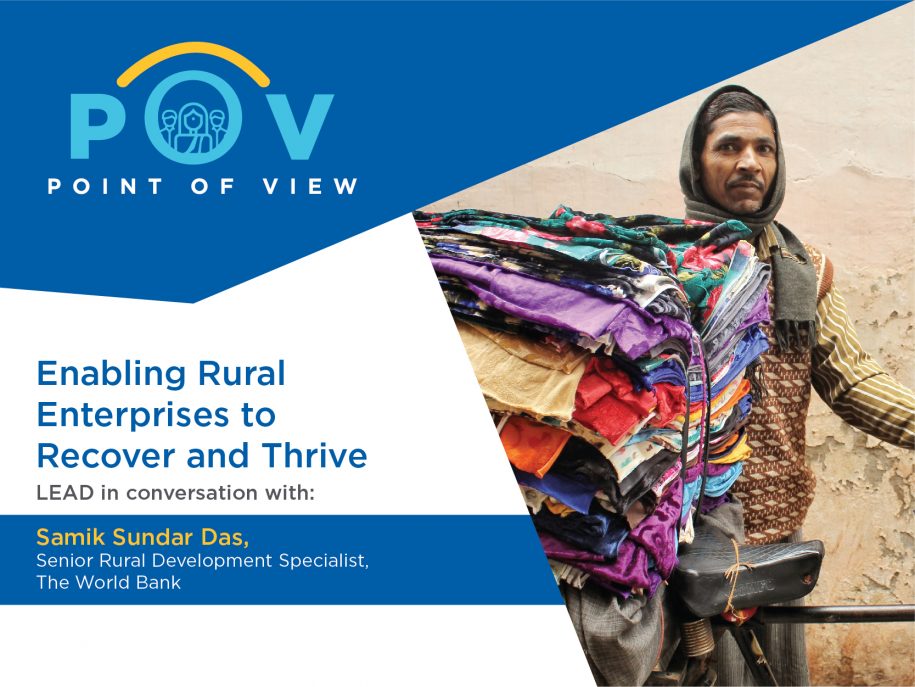Introducing our new feature series ‘Point of View’, where we speak with experts from different sectors to unpack some of the complex development challenges that they are working on and learn from their experiences.
LEAD has been working in the MSME space for over a decade and a half – looking at questions such as why are small businesses stuck in low productivity traps, and what kind of interventions can help them access capital, technology and build skills in new areas. On the occasion of World Micro, Small and Medium Enterprises Day (June 27), LEAD’s Senior Learning Manager Diksha Singh caught up with Samik Sundar Das, Senior Rural Development Specialist with the World Bank, to discuss policy priorities and strategies for enabling rural enterprises. This article includes excerpts from the interview.
Can you tell us a little about how the pandemic and the lockdowns have affected the rural economy and rural enterprises in particular? And how do some of the effects differ from what we are seeing in urban areas?
In the rural economy, there are a lot of informal enterprises that may not fit the criteria of the MSME definitions as they are below a certain investment and employment threshold. We have identified a new segment of enterprises – nano-enterprises or potential growth enterprises, this needs recognition at the policy level. Against this backdrop, the first wave of COVID disrupted the normal way of business for these nano-enterprises, affecting supply chains, access to inputs, raw materials and cash flows.
As the lockdown progressed, there was more clarity on guidelines for the movement of essential goods and other commodities. However, the economy was stagnant in the initial period of the lockdown. As a result, many of these nano enterprises were struggling to stay afloat, also these businesses felt the ripple effects of the slowdown in peri-urban or urban economies.
The biggest challenge faced by the enterprises was access to working capital to stay in business. Many of these businesses invest their daily earnings into purchasing inputs for trading or production, which is across the farm, non-farm and off-farm sectors.
We also observed differences across the two waves, as during the second wave there was tremendous stress on health infrastructure and services, and infection rates in rural areas were also going up. Hence, there is an overall slowdown in business transactions and the rural local economy overall, and the non-farm sector, particularly handmade and handicraft sub-sectors, are badly hit.
Apart from the working capital crunch that was seen across waves, what are some of the other challenges that enterprises are facing in staying afloat?
Many rural households were dependent on the remittance economy, and were building their livelihoods portfolio – trying to move up the ladder and expand their businesses in line with their aspirations. In many cases, these households live just above the poverty threshold (living on or just above ~4 USD/day) and face the risk of falling back into poverty. We need to have a strategy to identify these households and ensure that they do not fall below poverty thresholds.
The lockdowns have resulted in a large influx of migrant workers returning to rural areas. What kind of spillover effects are you seeing from this reverse migration?
We lack reliable data on the scale and extent of reverse migration along various corridors to rural and peri-urban areas. In the short-term, returnee migrants have taken up NREGA activities. The increase in availability of labor has also contributed to bumper agricultural production last year. Given their contribution to the labor force, as inputs to agriculture and production, any shifts in migration have larger implications for the economy and there is a need for a systematic approach to understanding these changes.
I see migration as a positive phenomenon that is a trigger for growth and contributing to urbanization. However, there is a need for a robust system for tracking migrants and understanding intra and inter-household dynamics of workers who migrate alone as well as those who migrate with their families. There is a gender element to this as well – when male members migrate, the burden of care and household work, as well as agricultural activities falls on women. There is a lot to be done on this front, including policies and dedicated investments in the medium and long term.
What are some of the promising or high-value farm and non-farm sectors that have absorbed returning workers, and where do you see the potential for generating more employment?
Agriculture remains the most labor-intensive sector in the economy today, and there is a need for making agriculture ‘business smart’. While I agree that there is a need to diversify and promote other sectors such as manufacturing and services, agriculture has to be made more viable – shifting from feeding people to creating productive jobs at scale.
With segments such as wellness, horticulture, and floriculture growing rapidly, there is scope to strengthen value chains across these sub-sectors e.g. shifting to more processing and value additions at a decentralized level (micro-small scale) within local economies. In the non-farm sector, there is significant scope for improving logistics with the demand for online delivery from e-commerce players such as Amazon and Flipkart rising in peri-urban and rural areas as well.
As real estate prices go up in rural areas with industries coming up, decentralized production using a hub and spoke model can be a way forward. For e.g. In Virudhunagar, Tamil Nadu, small garments units have been set up with assistance from the project and technical support from the World Bank and these units supply their products to garment industries. They employ women who have switched from farming or unskilled jobs. The collaboration between the enterprise clusters and the private sector entities was facilitated by the Tamil Nadu Rural Poverty Reduction Project and is a win-win for all. Similar models can be adapted in other sectors as well.
Women’s collectives have played an instrumental role in the frontline response to COVID, while adapting their businesses and livelihoods to shocks. From an enterprise development perspective, what lessons can we draw from their experience in coping with the current scenario?
Women’s collectives in India are like the Indian railways – with extensive penetration, across 560,000 villages. The National Rural Livelihoods Mission has created a phenomenal network of people who have been organized into Self-Help Groups, Village-level, panchayat and cluster-level federations. This structure is well-integrated with State Missions and the national mission, with support from over 25,000 facilitators at various levels. This network has been leveraged by the banking sector, and as some estimates suggest, there is around USD 72 billion of financial capital revolving in the rural economy through the SHG network today.
Women’s collectives have also been instrumental in improving last-mile service delivery, particularly below the block level in rural areas. In the COVID context, paraprofessionals such as ASHAs and community resource persons have acted as first-responders – building awareness among rural households, monitoring affected households, running community kitchens and manufacturing masks, sanitizer and other PPE gear.
In states such as Jharkhand, Karnataka, Odisha, Bihar and Tamil Nadu, collectives engaged in horticulture together with the agriculture department and community-based organizations, ensured the supply of vegetables and other essential commodities to peri-urban and urban areas.
There has also been a lot of focus on the adequacy of policy measures introduced for the micro and small business segment. In this context, can you talk about the genesis of the COVID assistance package introduced in Tamil Nadu?
The initial idea was to provide some form of economic stimulus for rural enterprises affected by the COVID crisis. We initiated discussions with the state administration and we were able to get buy-in for the stimulus measures. As a result, around INR 300 crores was allocated for the package under the Tamil Nadu Rural Transformation Program (TNRTP).
The program was structured to provide working capital, one-time grants and other forms of assistance to different types of vulnerable groups. We focused on individual nano and micro-enterprises that were at risk of closing down; small and marginal farmers who could be targeted by TNRTP with help from technical support agencies working with farmer producer organizations and clusters; and enterprise groups in non-farm sectors such as pottery.
The program has also focused on inclusion as a key pillar. We have worked with village poverty reduction committees to identify particularly vulnerable population segments such as widows, destitute and the differently-abled. Lastly, given the large numbers of skilled youth and workers returning home, aspiring entrepreneurs were included in the program as well. Nearly ~50,000 returning migrants have started their own activities, such as mobile vegetable delivery, food cart, automobile repairing etc.
Apart from the financial assistance provided in the package, what are some of the other forms of support/facilitating services bundled with this?
Finance was only one element of the assistance package. We wanted to ensure that the enterprises become viable and self-sustaining, beyond the period of the grants and soft loans. In the case of farmers, TNRTP focused on linking them to markets and aggregating the purchase of inputs to get competitive prices and improve distribution at scale, by acting as a bridge between line departments and cooperatives.
- Improving convergence between efforts of different departments as well as across sectors helped address challenges of information asymmetry which would have otherwise hampered the program’s uptake and success.
- Communication was an important aspect as well, and WhatsApp groups were formed to coordinate delivery and to connect with beneficiaries.
- A web-based portal has been developed to register the supported enterprises and entrepreneurs currently efforts are on to identify the growth enterprises and the more aspirational entrepreneurs to provide customized support and take them to next level – the target is to work with at least 6000 such individual enterprises and create jobs in the local economy.
What were some of the enabling factors that helped catalyze the design and roll-out of the COVID assistance package in Tamil Nadu, given the logistical challenges posed by the pandemic? How has the Tamil Nadu experience informed similar initiatives in other states?
However, the ongoing impact evaluation will establish attributable results, and we are eagerly waiting for them.
“Convergence and collaboration between different stakeholders and institutions – from state departments and district administrations and nodal officers to community-based agencies working on the ground was critical to ensure timely and effective rollout.”
Based on the outreach and inclusion demonstrated by the program, we have recommended a similar package to the government of Odisha and the state government has mobilized resources for a similar package internally. A similar package has been recommended to the NRLM as well. This is a testament to the program.
What are 2-3 priority areas that the ecosystem should focus on to enable enterprise recovery in the short-term, as well as build the resilience of these enterprises against future shocks, and enable them to scale up?
Situating enterprise development approaches in the local context is an important first step. Understanding the local economy and how it is integrated with the peripheral and larger economy is critical to creating the right bridges. There are various aspects in an ecosystem approach – improving access to infrastructure such as road and electricity and digital infrastructure, access to finance, mentorship and skill-building. We need to have a holistic approach and improve coordination between various actors – policy, multilateral organizations, and industry.
There is also a big gap in the financial sector’s understanding of the rural economy, and how this translates into the right products and services. Along with promoting access to finance, organizing mentorship and skill-building around skill demand in local economies are very crucial.
We also need a better macro understanding of how the capital revolving within the SHG network is contributing to the livelihood basket of rural households, from an accountability and learning perspective.
What are some potential strategies to bridge the data gaps in the micro and small enterprise segment?
There is huge poverty of data on this segment, and we need reliable data from a planning perspective. For instance, we need to look at the incentives for sharing data and monetizing data where possible – to encourage enterprises to come forward and share this data voluntarily, while safeguarding their privacy. Educating enterprises to use data for their own planning is important as well as focusing on analytics to draw the right insights.
There is also some hesitation on the part of enterprises to formalize, because of various compliances. Micro and nano enterprises prefer to operate in a cash economy, given a choice where it’s simple and they can navigate by themselves, I am sure they would like to be formalized and benefit from various schemes and programs that the government has introduced to promote them.
And finally, LEAD is collaborating with the World Bank on various initiatives in Tamil Nadu and other states. How do you see these collaborations shaping the trajectory and impact of the programs?
LEAD has been an excellent knowledge partner, particularly in the state of Tamil Nadu, in preparing the guidelines for the Matching Grants Program, the evaluation of the COVID assistance package, and supporting the NRETP at the national level. These partnerships are crucial in generating learnings and knowledge, as well as asking the right questions to provide policy input.
I see the potential for LEAD and other research organizations to provide strategic support through more action-oriented and process research, which can feed into the implementation of programs; we look forward to working with LEAD as a partner in the future as well.
The findings, interpretations, and conclusions expressed in this article are entirely those of the author/speaker(s) and should not be attributed in any manner to the World Bank, to its affiliated organizations or to members of its Board of Executive Directors or the countries they represent.
Samik Sundar Das is a Senior Rural Development Specialist with The World Bank. He has nearly two decades of experience in working with government line ministries, Civil Society Organizations and private foundations in areas of Community-Driven Development, human resource development, community-based skilling and micro-business promotion for around two decades. He has contributed extensively towards the preparation and implementation of large-scale rural development programs. His current passion is to rejuvenate the intrinsic entrepreneurial zeal of women entrepreneurs and catalyse business ecosystem development for women-led enterprises.






